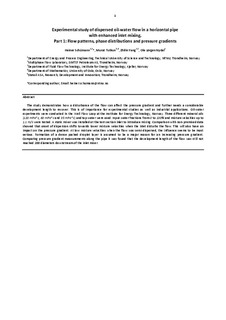| dc.contributor.author | Schümann, Heiner | |
| dc.contributor.author | Tutkun, Murat | |
| dc.contributor.author | Yang, Zhi Lin | |
| dc.contributor.author | Nydal, Ole Jørgen | |
| dc.date.accessioned | 2017-08-31T07:02:13Z | |
| dc.date.available | 2017-08-31T07:02:13Z | |
| dc.date.created | 2016-10-18T11:59:30Z | |
| dc.date.issued | 2016 | |
| dc.identifier.citation | Journal of Petroleum Science and Engineering. 2016, 145 742-752. | nb_NO |
| dc.identifier.issn | 0920-4105 | |
| dc.identifier.uri | http://hdl.handle.net/11250/2452473 | |
| dc.description.abstract | The study demonstrates how a disturbance of the flow can affect the pressure gradient and further needs a considerable development length to recover. This is of importance for experimental studies as well as industrial applications. Oil-water experiments were conducted in the Well Flow Loop at the Institute for Energy Technology, Norway. Three different mineral oils (120 mPa s, 60 mPa s and 35 mPa s) and tap water were used. Input water fractions from 0% to 100% and mixture velocities up to 1.1 m/s were tested. A static mixer was installed at the test section inlet to introduce mixing. Comparison with non-premixed data showed that onset of dispersion shifts towards lower mixture velocities when the inlet disturbs the flow. This will also have an impact on the pressure gradient. At low mixture velocities when the flow was semi-dispersed, the influence seems to be most serious. Formation of a dense packed droplet layer is assumed to be a major reason for an increasing pressure gradient. Comparing pressure gradient measurements along the pipe it was found that the development length of the flow was still not reached 200 diameters downstream of the inlet mixer. | |
| dc.language.iso | eng | nb_NO |
| dc.publisher | Elsevier | nb_NO |
| dc.rights | Attribution-NonCommercial-NoDerivatives 4.0 Internasjonal | * |
| dc.rights.uri | http://creativecommons.org/licenses/by-nc-nd/4.0/deed.no | * |
| dc.title | Experimental study of dispersed oil-water flow in a horizontal pipe with enhanced inlet mixing, Part 1: Flow patterns, phase distributions and pressure gradients | nb_NO |
| dc.type | Journal article | nb_NO |
| dc.type | Peer reviewed | nb_NO |
| dc.description.version | acceptedVersion | nb_NO |
| dc.source.pagenumber | 742-752 | nb_NO |
| dc.source.volume | 145 | nb_NO |
| dc.source.journal | Journal of Petroleum Science and Engineering | nb_NO |
| dc.identifier.doi | 10.1016/j.petrol.2016.06.005 | |
| dc.identifier.cristin | 1392586 | |
| dc.relation.project | Norges forskningsråd: 174974 | nb_NO |
| dc.description.localcode | © 2016 Elsevier B.V. All rights reserved. This is the authors' accepted and refereed manuscript to the article. Locked until 14 June 2018 due to copyright restrictions. | nb_NO |
| cristin.unitcode | 194,64,25,0 | |
| cristin.unitname | Institutt for energi- og prosessteknikk | |
| cristin.ispublished | true | |
| cristin.fulltext | postprint | |
| cristin.qualitycode | 2 | |

